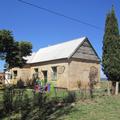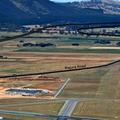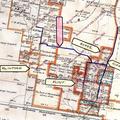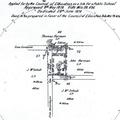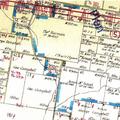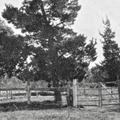< Early Canberra Government Schools
Majura School [1874 - 1930]
Rev Father James McAuliffe, Queanbeyan's Roman Catholic priest applied on 13 May 1874 for a Provisional School to be established at Majura. Father McAuliffe was actively involved from around 1870 in the establishment of a number of schools in the Canberra - Queanbeyan area, including Burra (1870), Tuggeranong (1870), Fell Timber (1874) and Bulga Creek (1878). McAuliffe's Majura initiative resulted in a formal application being submitted on 8 June 1874 by Michael O'Rourke, Michael Darmody and Thomas Mulqueeny. John McIntosh wrote to the Council of Education on 5 August 1874 indicating that the school would be ready by the end of the month and asked that a teacher be appointed.
The Inspector reported that the building suggested by McIntosh was a house standing on the border of the school site (Portion 71) Parish of Pialligo, but stated that it would serve the purpose until a school could be built. He stated that Christopher Flanagan, whom Father Calif had recommended as teacher was an old man without education, and he proposed that Catherine Corbett be recognised as teacher. Aid was granted for the school on 8 October 1874 and £5 was provided towards the cost of furniture.
After three years in the post Miss Corbett resigned on 1 January 1878 stating that the attendance was not sufficient to support her (the teacher's salary was supplemented by fees paid by the pupils). Kate Abernethy replaced her but stayed only until the end of 1878. Subsequent teachers did not remain long at the school and in June 1883 when attendance was falling, teacher Catherine Stafford furnished the names and ages of the eleven children living within two miles of the school:
'Flora Cameron 9, Christina Warwick 12 Frances Gifford 9, Emily Robinson 12, Margaret Cameron 7, Martha Penny 11, Angus Cameron 11, James Harman 9, Duncan Cameron 9, Cornelius O'Rourke 8, Edward O'Rourke 6'.
She may well have been anxious at the low level of enrolments and future prospects for the school. By May 1884 the Inspector reported that the enrolment at the school had fallen to ten and soon only nine would be available. This resulted in the school being closed for nearly three years.
John McIntosh wrote to the Minister for Public Instruction in December 1886 seeking the re-opening of the school, listing the names of eighteen children who were likely to attend. The re-opening was approved in January 1887 and Catherine Hogan took up duty in February (but resigned shortly after at the end of May).
Although primary schooling was officially 'free, secular and compulsory' following passage of the 1880 Education Act, parents were still liable for fees. They could be waived in cases of hardship however. Mrs Lucy Wainwright, a widow 'living on charity' had her debt of 17/6d cancelled in March 1891 on the recommendation of Hogan's successor as teacher, Mary Madigan.
Malcolm Vale school
In late 1891 a group of parents from the district three or four miles south east of Majura applied for the establishment of a Half Time school at Malcolm Vale, claiming that fourteen children were ready to attend. Four of them were already attending Majura however, which at that stage had an enrolment of only twelve. Against the wishes, and the petitioning, of the Majura parents, Inspector Cooper recommended in favour of a new Half Time school at Malcolm Vale, and that it partner with Majura. Cooper appended to his advice a sketch map of the locality, marking the proposed site of the Malcolm Vale school. It is still to be determined if that is where the school was actually located. Silas Clifton, recently appointed to Majura, found himself teaching at two schools. Inspector Cooper was 'doubtful as to his ability to conduct satisfactorily two Half Time schools', and a subsequent file note observes that Silas Clifton was 'Informed that.... arrangements will be made at an early date for his removal to a small full-time school'. He was removed to Barnes Creek (September 1892), and from then moved to Mugwill (1895).
By 1897 Majura was again on the rise, with an enrolment of 25 and average attendance of 20. Inspector Cooper reported that a new school building was required. Majura school had been erected 'about 25 years ago', was uncomfortable, unsafe, and not worth repairing. He recommended that the now unused Canberra school at 'Springbank' be transported to Majura and re-erected with the addition of a veranda and new fireplace. This was approved, tenders were invited in June, and the work carried out to Cooper's very detailed specifications by Mr. J. Jordan, at a cost of £27.10.0. Two desks, four forms, one book press, and six wall tablets were supplied to the 'new' school. From 1898 through to 1916 Majura was a fully fledged Public School and for a short while part of an 'incipient village' that included a church, a community hall, and post office.
A school on the move
By 1913 the centre of gravity of the Valley's population had evidently shifted northwards, and it was decided to move the school north also, to a site on Joseph Cooper's block (Portion 36). Three years later in 1916, the school closed, and was not to open again until 1923 – as a Subsidised School operating at 'Limestone House'. Meanwhile a contract at 35/- a week was offered to Mr W Darmody to transport his own and the O'Rourke children to the school at Duntroon, and controversy arose when Darmody failed for a while to fully carry out the transport duties. He sought to explain why in a letter of 22nd November 1922:
"The reason the children were not at school for period mentioned I required the horse and sulky to convey the shearers to and from the homestead for their meals. I further wish to point out the horse and sulky is my property and was the only conveyance I had. No one has contributed a penny to the purchase of horse, sulky and harness with I have placed at the disposal of the children"
The Subsidised school operated from 12th February 1923. By the end of 1925 it was generally agreed that it had produced very unsatisfactory results. As there was still a steady core of children in the locality the options were considered of either transporting the children to Duntroon, or upgrading Majura to Provisional school status. The first option would be expensive, and anyway, Duntroon was already overcrowded. Majura therefore became a Provisional School once more in 1926, and was moved into the Majura Community Hall - after it had been appropriately refurbished. The Community Hall is still standing.
The building the school had previously been occupying - variously described as 'an old abandoned farm house' and a 'renovated farm building' - was on Block 42, Gungahlin, which was being leased by the Lands Department for farming, and so no longer available.
Majura school finally closed at the end of the school year in 1930. Seven or eight years later, after questions from the Chief Auditor, the remaining school furniture was subject to a 'stock-taking' and removed to the Vocational Training School at Kingston. A few years earlier Mr S W Edlington of 'Sunnyside', Majura, had successfully negotiated acquisition of an unused school desk for his daughter, who was enrolled with the School of the Air.
Provisional School Majura
On Friday had we pleasure of visiting the school in the above locality and were gratified to see the cleanliness and order therein preserved. Considering the scattered population it was surprising to see so many children in attendance. There are nearly 30 names on the roll we believe and on the day in question there were 17 children present. The teacher, a Miss Kate Corbett who appears to be well fitted for her duties..."
[Goulburn Evening Post 28.11.1876]
References
School history compiled from various sources, but particularly Lyall Gillespie, Early Education and Schools in the Canberra region, 1999, pp 19-20
Outline of European nineteenth-century land settlement and the cultural heritage of the Majura Valley can be found here (see page 14 ff.)
National Archives, Majura School - A1,1938/4661; A361, DSG19/451
Location Map
Related Photos
Teachers
- Corbett, Catherine
10/1874 - 12/1877 - Abernethy, Kate
01/1878 - 12/1878 - Hill, Elizabeth
02/1879 - 11/1881 - Brook, Elizabeth
11/1881 - 12/1882 - Stafford, Catherine
02/1883 - 05/1884 - Hogan, Catherine ('Katie')
01/1887 - 05/1887 - Madigan (Mrs Roberts), Mary Ellen
06/1887 - 12/1991 - Clifton, Silas Edwin
03/1892 - 09/1892 - Caffrey, Thomas
Half Time, 09/1892 - 09/1895 - Curley, Thomas A.
Half Time, 10/1895 - 01/1896 - Shannon, Louis J.
01/1896 - 10/1897 - McGrath, Bridget
10/1897 - 03/1901 - Salter, Miss Violet M.
03/1901 - 05/1906 - Mangan, Mary E.
07/1906 - Trotter, Alexander (Thomas)
08/1906 - 07/1911 - Anderson, Miss Beatrice Amelia
08/1914 - 06/1916 - Barron, Miss (?)
Subsidised school, 1923 - 1925 - Keeling, Gray
02/1926 - 03/1927 - Doherty, Owen
03/1927 - 09/1928 - Minchin, Arthur
10/1928 - 02/1930 - Triglone, Harry
02/1930 - 12/1930
NSW Government schools from 1848
- Majura School (external link)
< Early Canberra Government Schools
If you are able to assist our work of identifying, documenting, and celebrating the early bush schools of the Canberra region, please contact us or .


